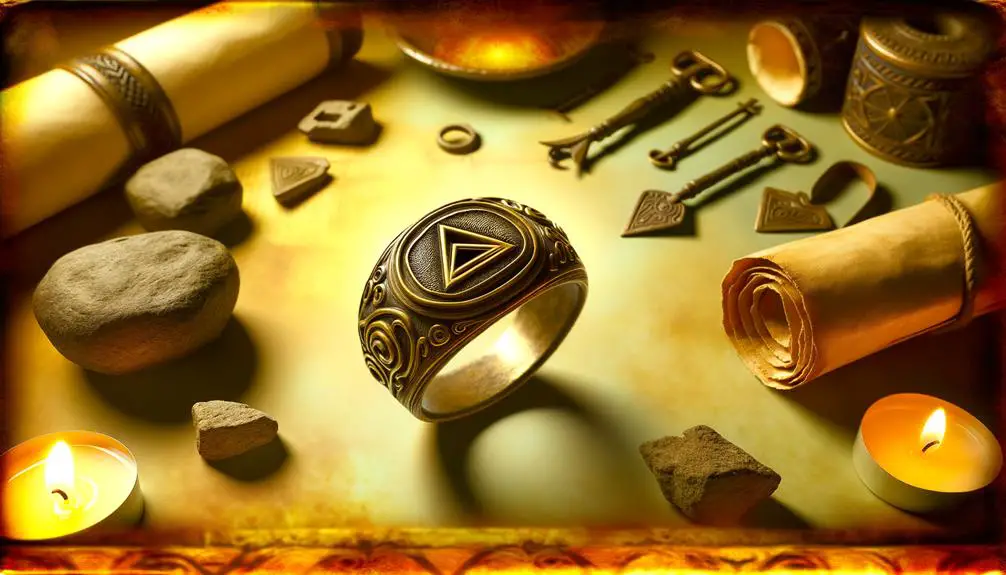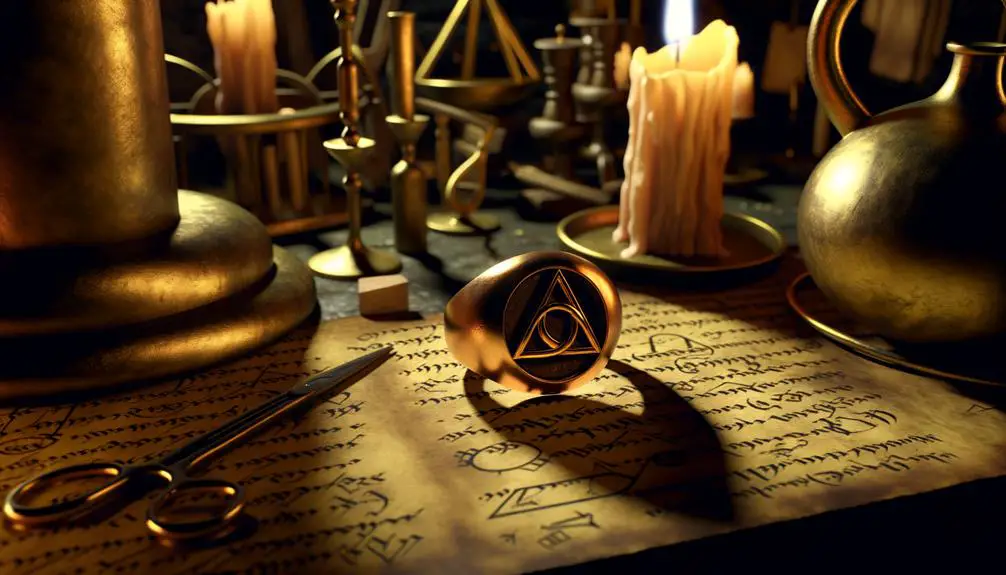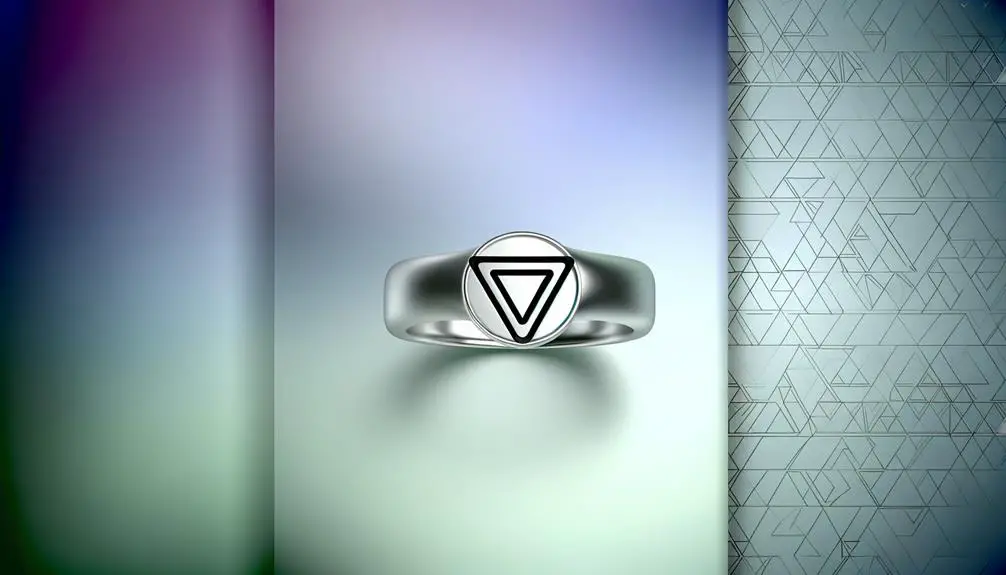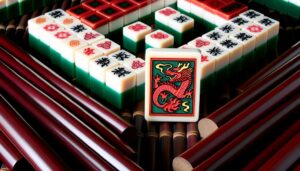Decoding the Triangle Symbol: Understanding the Meaning of Triangle Rings
A ring with a triangle symbol carries deeply layered meanings across various contexts. Historically, triangles were revered in Ancient Egypt, Greece, and Mesopotamia, symbolizing stability and profound philosophical ideas.
Spiritually, it represents balance, enlightenment, and the interconnectedness of mind, body, and spirit. In alchemy, the triangle signifies elemental forces such as fire and water.
Culturally, the triangle conveys strength, transformation, and unity, as seen in Hinduism and Celtic traditions. Modern interpretations emphasize minimalism and symbolic richness.
These diverse perspectives imbue the triangle ring with nuanced significance, inviting deeper exploration of its timeless allure.

Key Takeaways
- Represents balance, enlightenment, and the triadic nature of mind, body, and spirit.
- Symbolizes the interconnectedness of past, present, and future, evoking spiritual growth.
- Associated with ancient civilizations, highlighting stability and eternal life, especially in Egyptian culture.
- Holds alchemical significance, representing elements like fire (upward triangle) and water (downward triangle).
- Embodies modern values of minimalism, strength, and individual expression, bridging ancient wisdom with contemporary themes.
Historical Origins

In tracing the historical origins of the triangle symbol on rings, one must explore ancient civilizations, where geometric shapes often held profound spiritual and cultural significance. The triangle, in particular, was revered in societies such as Ancient Egypt, Greece, and Mesopotamia, where it symbolized elements like harmony, strength, and the divine.
In Egyptian culture, the triangle was integral to the pyramids, embodying stability and the connection between the earthly and the celestial. Greek philosophers like Pythagoras saw the triangle as a representation of the tripartite nature of existence. Mesopotamians frequently used triangular motifs in their art and architecture, reflecting cosmic order.
Therefore, the triangle's historical resonance is deeply embedded in the annals of early human civilization.
Spiritual Interpretations
Drawing from its rich historical significance, the triangle symbol on rings continues to hold profound spiritual interpretations in modern times, often representing concepts such as balance, enlightenment, and the triadic nature of existence. This geometric form is deeply embedded in various spiritual doctrines, signifying the interconnectedness of mind, body, and spirit. It also evokes the harmony between past, present, and future, thereby serving as a potent reminder of life's cyclical nature. The symbolic resonance of the triangle can be further appreciated through the following associations:
| Concept | Spiritual Meaning |
|---|---|
| Balance | Harmony and equilibrium |
| Enlightenment | Spiritual awakening and insight |
| Triadic Nature | Interconnectedness of all things |
| Cyclicality | The eternal flow of existence |
This enduring symbol inspires profound reflection and spiritual growth.
Alchemical Significance

The triangle symbol on rings holds significant alchemical meanings, often representing the fundamental elements of nature and the transformative processes within alchemical practices. In alchemy, triangles are intrinsically linked to the classical elements: fire, water, air, and earth.
An upward-pointing triangle signifies fire, symbolizing transformation, purification, and energy. Conversely, a downward-pointing triangle denotes water, reflective of intuition, fluidity, and the subconscious. When intersected, triangles form the hexagram, a potent emblem of the union of opposites—masculine and feminine, spiritual and material.
These geometric forms are not mere symbols but are imbued with deep alchemical wisdom, underscoring the practitioner's journey toward achieving the 'Philosopher's Stone,' a metaphor for personal and spiritual enlightenment. Hence, rings bearing these symbols serve as powerful talismans.
Cultural Perspectives
Exploring cultural perspectives on the triangle symbol in rings reveals a rich tapestry of meanings and significance across various societies and historical contexts.
In ancient Egypt, triangles were emblematic of the pyramids, representing strength and eternal life.
In Hinduism, the upward-pointing triangle symbolizes Shiva, embodying masculinity and fire, while the downward-pointing triangle represents Shakti, denoting femininity and water.
The Jewish Star of David, composed of two interlocking triangles, signifies unity and divine protection.
Celtic traditions often utilized triangular knots to symbolize the interconnectedness of life, death, and rebirth.
Similarly, in Greek culture, triangles were associated with the delta, a symbol of change and transformation.
These diverse interpretations underscore the triangle's profound and multifaceted significance across human civilizations.
Modern Symbolism

In contemporary contexts, the triangle symbol in rings often embodies a convergence of minimalism, spirituality, and personal empowerment, reflecting a nuanced synthesis of traditional meanings and modern aesthetics. This geometric shape is imbued with multilayered significance, aligning with today's emphasis on individual expression and deeper existential themes. Modern wearers find resonance in the triangle's versatility, which can signify:
- Balance and Harmony: Representing the equilibrium between mind, body, and spirit.
- Change and Progress: Depicting dynamic movement and the evolution of self.
- Strength and Stability: Symbolizing a strong foundation and resilience.
The incorporation of the triangle in ring designs speaks to a broader cultural trend towards simplicity and symbolic richness, bridging ancient wisdom with contemporary values.
Triangle Types in Jewelry
Categorizing the various triangle types in jewelry reveals a profound diversity in form and meaning, each variant contributing uniquely to the artistry and symbolism of the piece.
Equilateral triangles, with their symmetrical balance, often symbolize harmony and equality.
Isosceles triangles reflect duality and stability, emphasizing the connection between two equal sides.
Scalene triangles, with their varied angles and sides, evoke dynamism and individuality.
In addition, the orientation of the triangle—pointing upwards or downwards—alters its interpretation.
Upward-facing triangles can denote ascension and fire, while downward-facing triangles frequently represent water and femininity.
The intricacies of these geometric forms underscore their versatility in embodying profound philosophical and cultural concepts, making them a cherished motif in jewelry design.
Choosing a Triangle Ring

When selecting a triangle ring, one must consider the symbolic importance, geometric shape, and material composition to guarantee the piece aligns with personal aesthetics and philosophical values.
The triangular shape can represent various meanings, such as balance, change, or enlightenment, which should resonate with the wearer's intentions.
Additionally, the geometry of the triangle—whether equilateral, isosceles, or scalene—affects the ring's visual appeal and symbolic interpretation.
The material composition, ranging from precious metals to gemstones, also plays an essential role in the overall aesthetic and durability of the ring.
These considerations guarantee an informed, meaningful choice.
Conclusion
In the kaleidoscope of history, spirituality, alchemy, and cultural narratives, the triangle symbol on a ring emerges as a multifaceted jewel, reflecting a spectrum of meanings.
It serves as an emblem of the past's wisdom, a spiritual guidepost, an alchemical cipher, and a modern fashion statement.
This geometric icon, with its myriad interpretations, continues to captivate and resonate, embodying a timeless allure that bridges ancient tradition and contemporary expression.






